Not that long ago, in a galaxy… well, it was in this galaxy, but it was a while ago now, fourteen-year-old me received a really awesome present: the Star Wars Trilogy Original Soundtrack Anthology, a four-CD box set that came with a booklet in which each track was described in terms of instrumentation, themes, what was going on in the movies during that track, and the composer’s intentions for each track. I spent that Christmas break with my Walkman (yes, a Walkman), some earphones, and a blown mind as I discovered that when people and places have their own themes in a movie, those themes can be mixed together, played on different instruments, and at different tempos to convey the action on the screen.
So, Star-Wars obsessed, music nerd Sara (I played violin and did choir, orchestra, and marching band) had been gifted with what amounted to a textbook for studying the variations and possibilities, and I jumped into it with the kind of weird, fevered devotion that only a fourteen-year-old girl can offer to her fandom.

OMG I love this soooo much!
What information about a movie, TV show, or video game is revealed via music? A melody, especially when interwoven with other melodies, can reveal key connections, emotions, and relationships between characters and sometimes places. Additionally, music can be used to foreshadow future events or reference the past. It can add some really interesting and cool dimensions to your existing fandoms when you are able to incorporate the emotions and connections between the score and characters or places.
If, for example, Aragorn and Legolas are your fandom characters of choice (whether they’re your OTP or your BroTP), Howard Shore’s music in the scene in The Two Towers where they make up after their argument is the motif known as “The Fellowship Theme,” first played in the first film when the Fellowship each has their Adventurer’s Glamorshot walking through the mountains after the Council of Elrond. In this clip, you hear the Fellowship Theme being played softly. Here, played in this moment, it is a reaffirmation of the personal fellowship between Aragorn and Legolas. Their friendship (or whatever) is still intact, even after their disagreement.
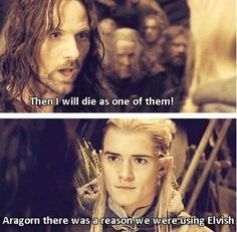
Elvish! We were arguing in Elvish so they WOULDN’T hear us and freak out!
In my Star Wars anthology, the track titles that are concert arrangements of themes are useful in that they are an excellent launching point for further exploration. For example, once you know what Han and Leia’s love theme sounds like, you can then recognize it within other tracks, like the part of the movie where Han Solo is being frozen (insert mental image of the Star Wars cast breaking out into strains of “Let It Go,”) in carbonite and they have their famous “I love you,” “I know” exchange. The track title is “Carbon Freeze/Darth Vader’s Trap/Departure of Boba Fett,” and it is nearly twelve minutes long. The track contains pieces of the Imperial March (often referred to as Darth Vader’s theme) as well the Jedi Fanfare often associated with Luke during action scenes.
Also present in this track is a battle-ready version of Yoda’s theme, which we first heard played softly and sometimes playfully during the scenes where Luke is training under Yoda on Dagobah. Yoda’s theme is used to represent the Force and to call to mind that Yoda was not too keen on Luke flying off to Bespin to save the day, thereby warning the savvy viewer that things are not going to go well for our hero. The swelling strings of Han and Leia’s theme provide the emotional payoff of this track. If you’ve seen the movie, the use of that theme, played in that way, during that scene does more than just tell the viewer that this is supposed to be sad — it brings the past and present together for the characters and for the audience as well.
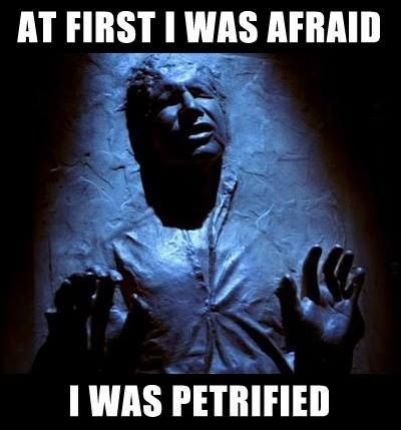
I am so sorry, you guys. This cracks me up!
The Pirates of the Caribbean movie scores provided a new playground for me to practice my movie and musical analysis skills. Klaus Badelt and Hans Zimmer collaborated on the scores for the Pirates of the Caribbean movies, often working with each other’s themes and arranging them into the score. Captain Jack Sparrow is introduced to the tune of “The Medallion Calls” theme, first played when he has stolen the small boat and sails to Port Royal. It can be interpreted to be almost an internal soundtrack-ing — it sounds like what Jack Sparrow would want his soundtrack to sound like and further evidences that his character is dramatic, often a bit full of himself, but ultimately heroic.
In fact, Jack Sparrow has at least two different theme songs; The Medallion Calls, and He’s a Pirate. One is the character’s idea of himself and the other represents how others see him. Jack’s theme(s) are used throughout the quadrilogy and are interwoven with other themes as Jack himself crosses paths with the characters those motifs represent. They also represent Jack’s warring nature — is he a hero or a pirate? The answer is provided both in the soundtrack as well as in the narrative of the movies. In the third film, both of Jack’s themes are woven together with other themes, including Tia Dalma’s, Davy Jones’s, and Will and Elizabeth’s themes.
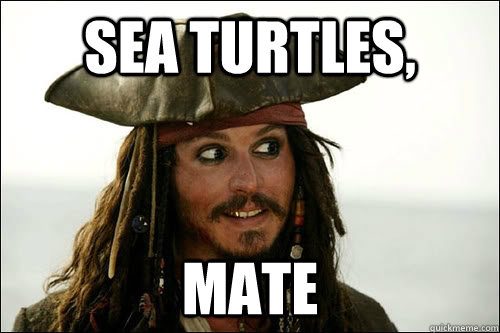
Human hair. From my back.
Like Jack Sparrow, Will and Elizabeth get multiple themes to explore the various aspects of their characters. The track “Will and Elizabeth” from the first movie introduces the adventurous side of the young couple. Pieces of this first theme are used to construct their love theme from the third movie, which is used to express the emotional side of Will and Elizabeth’s relationship. In the third Pirates movie, these themes show up again during the final fight scene, played with increased tempo to fit the action sequence. This use of the musical score emphasizes traits of the characters — yes, they’re in love, but they’re so much more than that! Elizabeth is a badass Pirate King, Will is the peaceful blacksmith-turned-hero, and they’re interacting with each other on multiple levels, just as the soundtrack does with the savvy (savvy?) listener.
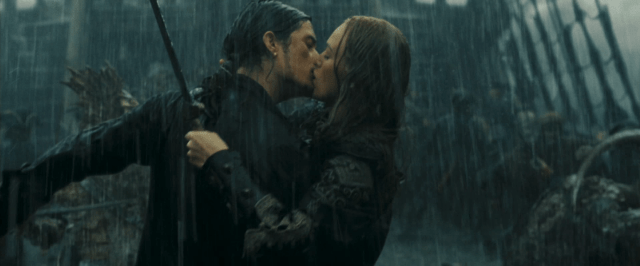
We’re so pretty.
Back to Star Wars for a bit to examine another motif with many uses. The Imperial March is introduced in The Empire Strikes Back, and although its official title would seem to imply that the theme represents the Empire as a whole, the theme has become synonymous with the character of Darth Vader. I believe that this was intentional, and was therefore meant to suggest that the Empire needs Vader more than he needs the Empire, making his change of heart near the end of The Return of the Jedi even more convincing.
Composer John Williams went back to plant those seeds when he composed Anakin’s Theme for The Phantom Menace. What starts out as an innocent theme song for a sweet little boy has an ominous musical “tag” at the end. A small piece of the Imperial March is present, suggesting to the viewer/savvy listener that this kid already has some dark tendencies hidden within. In The Return of the Jedi when Darth Vader is dying, the once-powerful Imperial March is played softly on a harp. The theme is shown to be as volatile and changeable as its owner, providing a character sketch in musical form, as well as showing the connections between characters and films.
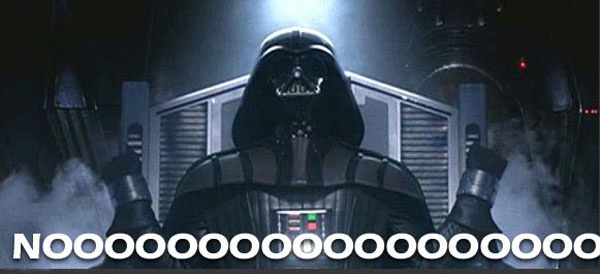
Nooooooooo! I mean really? Lava? Amputations? Haven’t I been through enough?
Place themes are often used to call to mind not only physical places, but also to connect those places to what they might represent to different characters. The Cloud City theme from The Empire Strikes Back sounds regal and safe, and calls to mind the image of Lando Calrissian, fabulous and dashing in his billowing cape. As it is revealed that Cloud City is not what it seems, however, the track is interwoven with the Imperial March, illustrating Cloud City’s entanglement with the Empire.
In The Two Towers, the Rohan theme is one of the most recognizable and prevalent themes. One of my favorite uses of the theme is in the scene where Gandalf returns Theoden King to his right mind. The Rohan theme plays strongly, solidifying the connection between Theoden and his country. In many ways, Theoden is Rohan – both suffering under Saruman’s influence and returned to their previous greatness. The tie between the land and its people is also heard in the pieces of the Rohan Theme present in Eowyn’s Theme. Eowyn’s own ties to and desire to defend her home being no less than Theoden King’s.
In The Fellowship of the Ring, the theme of the Shire, called “Concerning Hobbits,” is often used to evoke the safety and peacefulness of Shire life. By the end of the trilogy, the motif that symbolizes the innocence of the Hobbits and of the Shire has also come to represent Frodo’s knowledge that he does not belong in such a place any longer. The theme, like the Shire, is mostly unchanged; however, Frodo has changed, and this is why he must go.
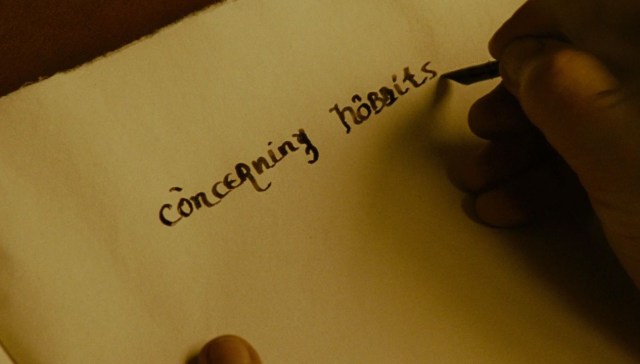
Aw, Mr. Frodo!
Not long after I fell in love with movie soundtracks, I began to notice that movies were not the only media with memorable soundtracks. The Final Fantasy series of video games has some truly memorable themes. I briefly touched on one of my favorites in a previous article. Kefka, the villain of Final Fantasy 3 (or 6, depending) has one of the best character themes for a villain I have ever heard. The original sound version is still one of my favorites, as it captures his character’s progress from Imperial Lackey to Holy Shit I’ve Seen the Universe and Found It Pointless God-On-A-Trash-Pile.
That said, there are some completely amazing orchestrations of it out there, a lot of them fan-made and many official in some capacity. A good place to start for those would be with this track, but I don’t think it has the range of the original, even if the sound quality is a vast improvement. For the full effect of Kefka’s madness and villainy, check out this orchestrated/choral version of Dancing Mad, the end battle music for Final Fantasy VI. Anyone who has doubts about the legitimacy of including video game soundtracks as “real” music, should go into a corner, listen to this version of Dancing Mad and, think about what they’ve done.
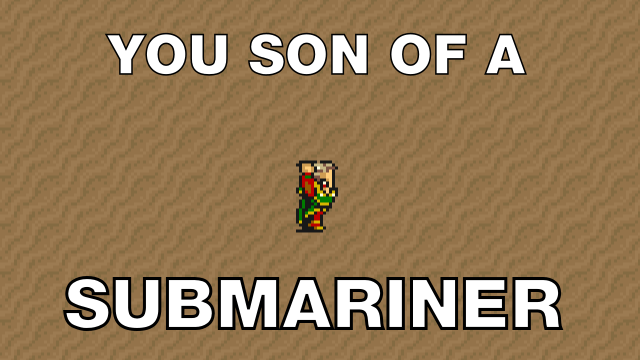
Son of a – submariner?
My own video game music knowledge is simultaneously vast and limited. Final Fantasy music? I’ve got that. Old Nintendo? Got that too. My mom actually made up lyrics to the underwater theme in Super Mario Brothers and I still remember the words. Other stuff? I’m a little weak on that. To bolster my knowledge, I asked my friend Saker Alexander, who has probably forgotten more about video games and music than I’ve ever even known, for some insight. And did I ever get it! Saker’s nerd cred is good – he runs panels that incorporate video gaming at conventions with the group Kick Punch QWOP.
The first thing he recommended that I check out was the iMUSE (Interactive Music Streaming Engine) created in the early 1990s by composers Michael Land and Peter McConnell. They were experiencing frustration with making the musical transitions between places in the LucasArts game Monkey Island, and created iMUSE to make the process more feasible. They wanted the musical motifs to be able to change back and forth as seamlessly as the character moved from screen to screen within the game. A really good video of what this means and what it looks like and sounds like in play can be found here. The effect that iMUSE had on game music is that it allowed the game experience to play more like a movie score might. A character’s movement determines the music, and just like in film scores, the specific action on screen and the music playing are connected, giving the player a more immersive, movie-like experience.
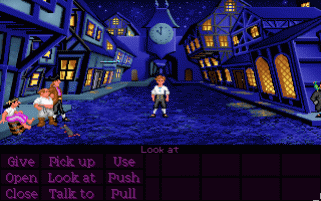
Monkey Island. Good times!
I’ve mentioned before how taking a motif and playing it with different instruments or at a different tempo can change the meaning and imply connection, and Saker pointed out that the game Chrono Cross contains a really good example of this. The “Home Arni Village” place theme music differs from the alternate world version, called, “Another Arni.” I think Saker summed this up best:
For example: you know you’re in your hometown, and it feels… mostly the same. But there’s just something a little wrong. Therefore, the home village gets a major key rendition, which feels comfortable and snuggly. Meanwhile, the alternate rendition is still soft and sweet, but the minor keys sprinkled in feel sad and lonesome. And, man, dedicated Chrono series fans will feel the motifs from Chrono Trigger splattered EVERYWHERE in this game, here and there.
When I first sent my article title to my friend to let him know what it was I was writing about and what kind of video game music I might be looking for, he mentioned an aspect of soundtrackage in general that I had not considered. I’ve covered character themes, how they connect certain characters to other characters or places, and I’ve covered some place themes, but the use of music to convey a sense of time was a new one for me. The soundtrack of the game Far Cry 3: Blood Dragon was written by the band Powerglove, and was apparently supposed to be very 1980’s action-movie-esque. Saker says that if the Blood Dragon theme “doesn’t make you feel like you’re watching every trailer before Robocop, something is wrong with you.” A better summary for a piece of music may never have been given, because nothing has ever sounded more like “running in the future in the ’80s” to me than that track. Dang.
And, this doesn’t fall into the category of instrumental scores, but check out this amazing song from Bioshock Infinite! God Only Knows by the Beach Boys, performed in a pseudo-1920’s barbershop quartet style. If that doesn’t make some kind of statement about the importance of music in establishing a sense of time in movies and games (especially a completely jacked sense of time like in Bioshock), I’m not sure what would do the job! Possibly this calliope version of Girls Just Want to Have Fun by Cyndi Lauper would do the trick? Yes? No?
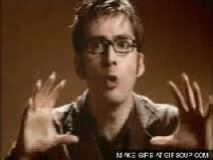
Wibbly wobbly timey wimey ….
So, if, after reading this article, any of you might be interested in trying out some soundtrack appreciation of your own, I recommend the Lord of the Rings soundtracks. After familiarizing yourself with the character and place themes, listen to the score from The Hobbit and see if you can find evidence of Peter Jackson’s decision to integrate the story of The Hobbit into the first trilogy via familiar characters, scenes, and sounds. The soundtrack acts as a prequel, just like the narrative, and evidence of this can be gleaned through paying attention to the musical motifs, and where they occur in the movie. Even if you don’t love the later movies, the exercise is still a good one to get you started on hearing the minute details that are often emphasized and clarified by the music.
The better you get at it, the more you will be able to predict possible outcomes of your media and gain deeper insight into the connections and motivations of the characters, enhancing the overall viewing experience (and subsequent fandom activities!) If you want to start listening to film scores to add a new dimension of appreciation to your existing fandoms, I recommend starting with some of the more “classic” types. Star Wars and Indiana Jones were my own personal training ground, and they prepared me for being able to fully appreciate later installations in nerd-canon like Pirates of the Caribbean, Harry Potter, Lord of the Rings, Edward Scissorhands, and Stargate.
With these staples of soundtrackage, you can get an idea of how to start listening to your new favorites as well. Track titles are your best friend and your worst enemy! If you’re listening to something you haven’t seen yet, track titles can contain spoilers. If you’re really good at recognizing individual themes and how they’re used within the score, the music itself can contain spoilers! Many times, I’ve listened to a track and thought, “Dammit. I think he dies. Why else would they be playing his theme like that? Why?” So – go forth, listen, and be wary of spoilers!

One out of one Dean Winchesters disapproves of your spoilers!
Many thanks to Saker Alexander for his most educational input on the video game music section, and for his suggestion of discussing how music can evoke a sense of time (or time-gone-weird). And also for being hilarious.
(top image by Margaret Napier)
Sara Goodwin has a B.A. in Classical Civilization and an M.A. in Library Science from Indiana University. Once she went on an archaeological dig and found awesome ancient stuff. Sara enjoys a smorgasbord of pan-nerd entertainment such as Renaissance faires, anime conventions, steampunk, and science fiction and fantasy conventions. In her free time, she writes things like fairy tale haiku, fantasy novels, and terrible poetry about being stalked by one-eyed opossums. In her other spare time, she sells nerdware as With a Grain of Salt Designs, Tweets, and Tumbls.
Are you following The Mary Sue on Twitter, Facebook, Tumblr, Pinterest, & Google +?



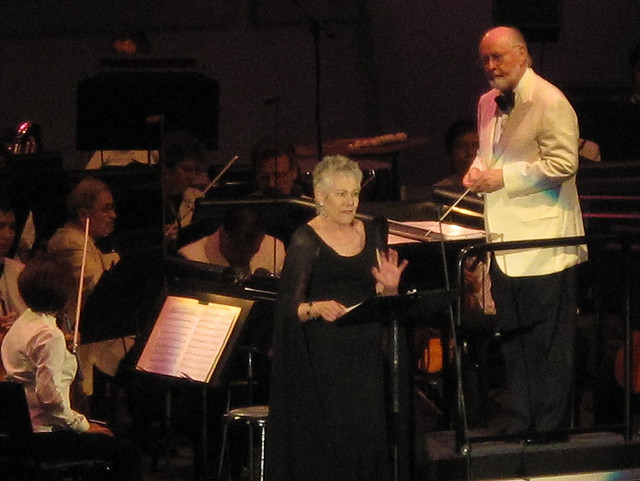





Published: Feb 25, 2015 08:00 pm